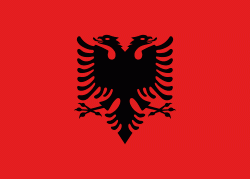Sarandë
Sarandë (Saranda; Άγιοι Σαράντα) is a city in the Republic of Albania and seat of Sarandë Municipality. Geographically, the city is located on an open sea gulf of the Ionian Sea within the Mediterranean Sea. Stretching along the Albanian Ionian Sea Coast, Saranda has a Mediterranean climate with over 300 sunny days a year.
Sarandë is known for its blue deep waters of the Mediterranean. Near Sarandë are the remains of the ancient city of Butrint, a UNESCO World Heritage site. In recent years, Saranda has seen a steady increase in tourists, many of them coming by cruise ship. Visitors are attracted by the natural environment of Saranda and its archaeological sites. Sarandë is inhabited by a majority of ethnic Albanians, and also has a minority Greek community and as such it has been considered one of the two centers of the Greek minority in Albania.
Saranda is from the name of the Byzantine monastery of the Agioi Saranda (Άγιοι Σαράντα), meaning the "Forty Saints" in the Greek language, in honor of the Forty Martyrs of Sebaste. Under Ottoman rule, the town in the Turkish language became known as Aya Sarandi and then Sarandoz. Owing to Venetian influence in the region, it often appeared under its Italian name Santi Quaranta on Western maps. This usage continued even after the establishment of the Principality of Albania, owing to the first Italian occupation of the region. During the Italian occupation of Albania in World War II, Benito Mussolini changed the name to Porto Edda, in honor of his eldest daughter. Following the restoration of Albanian independence, the city employed its Albanian name Saranda.
Sarandë is known for its blue deep waters of the Mediterranean. Near Sarandë are the remains of the ancient city of Butrint, a UNESCO World Heritage site. In recent years, Saranda has seen a steady increase in tourists, many of them coming by cruise ship. Visitors are attracted by the natural environment of Saranda and its archaeological sites. Sarandë is inhabited by a majority of ethnic Albanians, and also has a minority Greek community and as such it has been considered one of the two centers of the Greek minority in Albania.
Saranda is from the name of the Byzantine monastery of the Agioi Saranda (Άγιοι Σαράντα), meaning the "Forty Saints" in the Greek language, in honor of the Forty Martyrs of Sebaste. Under Ottoman rule, the town in the Turkish language became known as Aya Sarandi and then Sarandoz. Owing to Venetian influence in the region, it often appeared under its Italian name Santi Quaranta on Western maps. This usage continued even after the establishment of the Principality of Albania, owing to the first Italian occupation of the region. During the Italian occupation of Albania in World War II, Benito Mussolini changed the name to Porto Edda, in honor of his eldest daughter. Following the restoration of Albanian independence, the city employed its Albanian name Saranda.
Map - Sarandë
Map
Country - Albania
 |
 |
| Flag of Albania | |
Albania has been inhabited by different civilisations over time, such as the Illyrians, Thracians, Ancient Greeks, Romans, Byzantines, Venetians, and Ottomans. The Albanians established the autonomous Principality of Arbër in the 12th century. The Kingdom of Albania and Principality of Albania formed between the 13th and 14th centuries. Prior to the Ottoman conquest of Albania in the 15th century, the Albanian resistance to Ottoman expansion into Europe led by Skanderbeg won them acclaim over most of Europe. Albania remained under Ottoman rule for nearly five centuries, during which many Albanians (known as Arnauts) attained high-ranking offices in the empire, especially in the Southern Balkans and Egypt. Between the 18th and 19th centuries, cultural developments, widely attributed to Albanians having gathered both spiritual and intellectual strength, conclusively led to the Albanian Renaissance. After the defeat of the Ottomans in the Balkan Wars, the modern nation state of Albania declared independence in 1912. In the 20th century, the Kingdom of Albania was invaded by Italy, which formed Greater Albania before becoming a protectorate of Nazi Germany. Enver Hoxha formed the People's Socialist Republic of Albania after World War II, modeled under the terms of Hoxhaism. The Revolutions of 1991 concluded the fall of communism in Albania and eventually the establishment of the current Republic of Albania.
Currency / Language
| ISO | Currency | Symbol | Significant figures |
|---|---|---|---|
| ALL | Albanian lek | L | 2 |
| ISO | Language |
|---|---|
| SQ | Albanian language |
| EL | Greek language |















